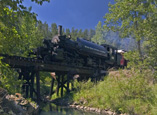History of Hill City
The history of Hill City reaches back into Pennington County’s oldest archives. In 1876, it was the first settlement established in conjunction with the initial discovery of Black Hills gold in French Creek, just 13 miles south of where Hill City sits today. Miners came from far and wide to prospect in and around this small mountain town, now referred to as “The Heart of the Hills.” Although the first settlement in the county, it was the second community to develop in the greater Black Hills area, springing up shortly after the town of Custer in Custer County.


After the bulk of gold prospecting relocated to the Northern Hills, Hill City reached a state of near abandonment by settlers before tin and the railroad drew the pioneers back in. From the mid-1880s to the turn of the century, the town revived and thrived on the discovery of tin, a malleable and silvery-white metal pulled from the rock in the Hills around the town. However, Hill City’s “tin age” was short-lived. When the tin frenzy subsided, the industrial railroad took over and dominated the first half of the emerging century. By the late 1950s, the Black Hills Central Railroad introduced the first passenger train on the line, commonly referred to today as the “1880 Train.”


In recent history, the Hill City community has continued to evolve as an archeological, paleontological, and geological hub for Black Hills exploration and discovery. The most complete Tyrannosaurus Rex skeleton in paleontological history was discovered in the Hill City area and named “Sue” after the paleontologist who unearthed her. Sue can be viewed today at The Field Museum in Chicago, Illinois. At the Black Hills Institute in Hill City, South Dakota, our community has on display its very own Tyrannosaurus Rex, named “Stan;” an original fossil, and the second largest and most complete on display, to date. In addition, the Black Hills Institute has many contemporary dinosaurs, land animals, and sea creatures, including the world’s largest sea turtle on display, an original fossil triceratops, and case displays that feature thousands of prehistoric fossils.
Throughout the course of Hill City’s colorful history, the town itself has continued to develop as a thriving community. As varying elements have drawn newcomers to the area over time, this original rough-and-tumble mining settlement has grown into a residential community supporting nearly 1000 inhabitants. Today, the area is powered by its lumber mill and the booming tourism industry. Although it continues to evolve as a modern focal point for art and culture in the Black Hills area, much of the old settlement has been preserved in Hill City’s handful of historical homes and buildings.


